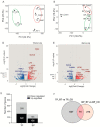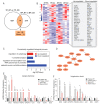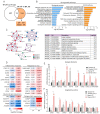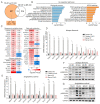Distinct Transcriptional Responses of Skeletal Muscle to Short-Term Cold Exposure in Tibetan Pigs and Bama Pigs
- PMID: 37108597
- PMCID: PMC10139196
- DOI: 10.3390/ijms24087431
Distinct Transcriptional Responses of Skeletal Muscle to Short-Term Cold Exposure in Tibetan Pigs and Bama Pigs
Abstract
Piglets are susceptible to cold, and piglet death caused by cold stress leads to economic losses in the pig industry in cold areas. Skeletal muscle plays a key role in adaptive thermogenesis in mammals, but the related mechanism in pigs is unclear. In this study, cold-tolerant Tibetan pigs and cold-sensitive Bama pigs were subjected to either a cold environment (4 °C) or a room temperature environment (25 °C) for 3 days. The biceps femoris (BF) and longissimus dorsi muscle (LDM) were collected for phenotypic analysis, and the BF was used for genome-wide transcriptional profiling. Our results showed that Tibetan pigs had a higher body temperature than Bama pigs upon cold stimulation. RNA-seq data indicated a stronger transcriptional response in the skeletal muscle of Tibetan pigs upon cold stimulation, as more differentially expressed genes (DEGs) were identified with the same criteria (p < 0.05 and fold change > 2). In addition, distinct pathway signaling patterns in skeletal muscle upon cold exposure were found between the breeds of pigs. Mitochondrial beta-oxidation-related genes and pathways were significantly upregulated in Tibetan pigs, indicating that Tibetan pigs may use fatty acids as the primary fuel source to protect against cold. However, the significant upregulation of inflammatory response- and glycolysis-related genes and pathways in the skeletal muscle of Bama pigs suggested that these pigs may use glucose as the primary fuel source in cold environments. Together, our study revealed the distinct transcriptional responses of skeletal muscle to cold stimulation in Tibetan pigs and Bama pigs and provided novel insights for future investigation of the cold adaptation mechanism in pigs.
Keywords: cold exposure; pig; skeletal muscle; transcriptome.
Conflict of interest statement
The authors declare no conflict of interest.
Figures






Similar articles
-
Transcriptome Analysis Revealed Potential Genes of Skeletal Muscle Thermogenesis in Mashen Pigs and Large White Pigs under Cold Stress.Int J Mol Sci. 2023 Oct 24;24(21):15534. doi: 10.3390/ijms242115534. Int J Mol Sci. 2023. PMID: 37958518 Free PMC article.
-
Single-nucleus RNA sequencing defines adipose tissue subpopulations that contribute to Tibetan pig cold adaptation.BMC Biol. 2025 Apr 24;23(1):107. doi: 10.1186/s12915-025-02211-0. BMC Biol. 2025. PMID: 40275312 Free PMC article.
-
Characterization of pig skeletal muscle transcriptomes in response to low temperature.Vet Med Sci. 2023 Jan;9(1):181-190. doi: 10.1002/vms3.1025. Epub 2022 Dec 8. Vet Med Sci. 2023. PMID: 36480456 Free PMC article.
-
Signaling Pathways Related to Protein Synthesis and Amino Acid Concentration in Pig Skeletal Muscles Depend on the Dietary Protein Level, Genotype and Developmental Stages.PLoS One. 2015 Sep 22;10(9):e0138277. doi: 10.1371/journal.pone.0138277. eCollection 2015. PLoS One. 2015. PMID: 26394157 Free PMC article.
-
Min pig skeletal muscle response to cold stress.PLoS One. 2022 Sep 26;17(9):e0274184. doi: 10.1371/journal.pone.0274184. eCollection 2022. PLoS One. 2022. PMID: 36155652 Free PMC article. Review.
Cited by
-
Hypothalamic Neuromodulation of Hypothermia in Domestic Animals.Animals (Basel). 2024 Feb 4;14(3):513. doi: 10.3390/ani14030513. Animals (Basel). 2024. PMID: 38338158 Free PMC article. Review.
-
Network Meta-Analysis: Effect of Cold Stress on the Gene Expression of Swine Adipocytes ATGL, CIDEA, UCP2, and UCP3.Curr Issues Mol Biol. 2024 Apr 25;46(5):3866-3876. doi: 10.3390/cimb46050240. Curr Issues Mol Biol. 2024. PMID: 38785508 Free PMC article.
-
Differential Analysis of Fecal SCFAs and Their Contribution to Adipogenesis in UCP1 Knock-In Pigs.Vet Sci. 2025 Feb 1;12(2):102. doi: 10.3390/vetsci12020102. Vet Sci. 2025. PMID: 40005862 Free PMC article.
-
The Role of lncRNAs in Pig Muscle in Response to Cold Exposure.Genes (Basel). 2023 Sep 30;14(10):1901. doi: 10.3390/genes14101901. Genes (Basel). 2023. PMID: 37895249 Free PMC article.
-
Genetic Adaptations of the Tibetan Pig to High-Altitude Hypoxia on the Qinghai-Tibet Plateau.Int J Mol Sci. 2024 Oct 21;25(20):11303. doi: 10.3390/ijms252011303. Int J Mol Sci. 2024. PMID: 39457085 Free PMC article.
References
MeSH terms
Grants and funding
LinkOut - more resources
Full Text Sources
Other Literature Sources
Miscellaneous

